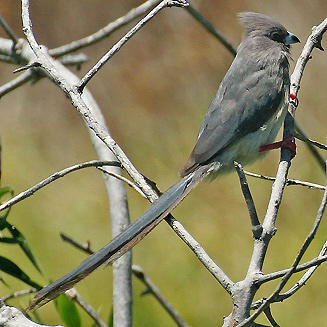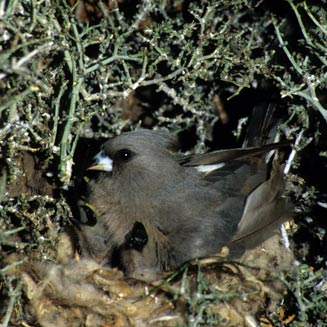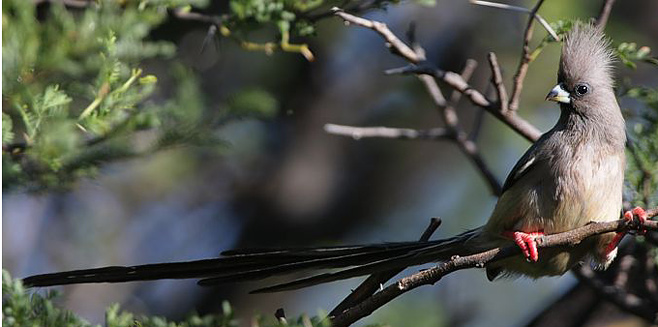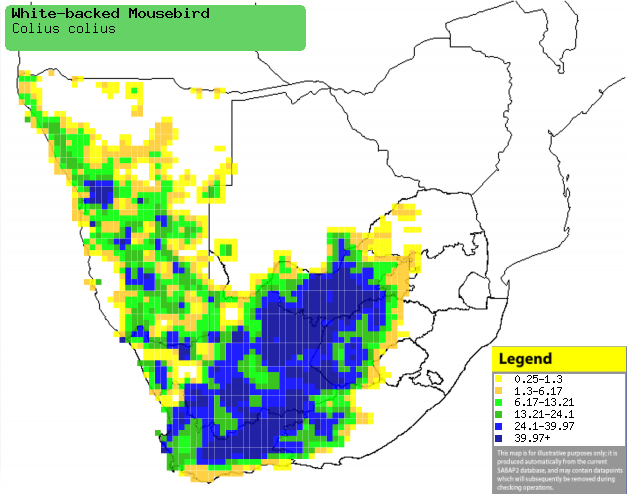|
Colius colius (White-backed
mousebird)
Witkruismuisvoël [Afrikaans]; Letsôrô, Mmamarungwane,
Rramatsiababa [Tswana]; Witstuitmuisvogel [Dutch]; Coliou à dos blanc [French];
Weißrücken-mausvogel [German]; Rabo-de-junco-de-dorso-branco [Portuguese]
Life
> Eukaryotes >
Opisthokonta
> Metazoa (animals) >
Bilateria >
Deuterostomia > Chordata >
Craniata > Vertebrata (vertebrates) > Gnathostomata (jawed
vertebrates) > Teleostomi (teleost fish) > Osteichthyes (bony fish) > Class:
Sarcopterygii (lobe-finned
fish) > Stegocephalia (terrestrial
vertebrates) > Tetrapoda
(four-legged vertebrates) > Reptiliomorpha > Amniota >
Reptilia (reptiles) >
Romeriida > Diapsida > Archosauromorpha > Archosauria >
Dinosauria
(dinosaurs) > Saurischia > Theropoda (bipedal predatory dinosaurs) >
Coelurosauria > Maniraptora > Aves
(birds) > Order: Coliiformes > Family: Coliidae
 |
 |
|
White-backed mousebird. [photo
Jim Scarff
©] |
White-backed mousebird brooding chicks on nest.
[photo Peter Steyn
©] |
 |
|
White-backed mousebird, Prince Albert, South Africa. [photo
Trevor Hardaker ©] |
The White-backed mousebird is endemic, being found mainly in
South Africa and Namibia. It prefers to live in sparse woodland, often with a
river nearby, also farmyards, gardens and orchards. It eats plant matter -
mainly fruit but also leaves, flowers, shoots and nectar. The nest is built by
both sexes, and is a scruffy bowl made of twigs, leaves and grass. It lays 1-6
eggs, which are incubated by both parents, for 11-13 days. Strangely, the chicks
are brooded non-stop, from when they hatch to when they leave the nest. In
captivity, the chicks stay in the nest for 11-20 days, becoming independent at
about 21 days old.
Distribution and habitat
Near-endemic to southern Africa, occurring from
south-western Angola to Namibia, western and cental South Africa and southern
Botswana.. It generally prefers the area around rivers running through sparse
woodland. It can also be found in farmyards, gardens and orchards. In the Western
Cape it is also common in Port Jackson willow (Acacia saligna) and Rooikrans
(Acacia
cyclops) thickets.
|
 |
|
Distribution of White-backed mousebird in southern Africa,
based on statistical smoothing of the records from first SA Bird Atlas
Project (©
Animal Demography unit, University of
Cape Town; smoothing by Birgit Erni and Francesca Little). Colours range
from dark blue (most common) through to yellow (least common).
See here for the latest distribution
from the SABAP2. |
Food
It feeds exclusively on plants, especially fruit but also
leaves, shoots, flowers and nectar. It usually forages in trees, bushes and
shrubs, rarely going down to the ground to pick up a fallen fruit. The following
food items have been recorded in its diet:
- Plants
- fruit
- Lycium (Honey-thorns)
- Mistletoe (Loranthaceae and Viscaceae)
- Atriplex semibaccata (alien Creeping saltbush)
- cultivated fruits
- leaves
- flowers
- Schinus molle (Pepper-tree)
- Melia azedarach (alien Persian lilac)
- Lycium (Honey-thorns)
- shoots
- nectar of
Aloe greatheadii (Spotted
Aloe)
Breeding
- The nest is built by both sexes, consisting of a small, shallow bowl of
twigs, leaves and grass. It is often lined with fluffy seeds, down and
occasionally sheep's wool.
- Egg-laying season is year-round, peaking from September-October.
- It lays 1-6, usually 2-4 eggs, which are incubated by both sexes for 11-13 days. Once the chicks have
hatched, the eggshells are trampled into the nest.
- Strangely, the chicks are brooded non-stop from when they hatch to when
they leave the nest. In captivity, the chicks stay in the nest for 11-20
days, becoming independent at about 21 days old.
Threats
Not threatened, although its population has been impacted by hunting by
fruit farmers, who consider them a pest.
References
-
Hockey PAR, Dean WRJ and Ryan PG (eds) 2005. Roberts
- Birds of southern Africa, VIIth ed. The Trustees of the John Voelcker
Bird Book Fund, Cape Town.
|
